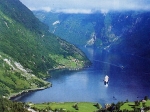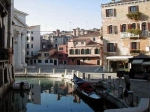
 The Republic of Poland , a country in Central Europe , lies between Germany to the west, the Czech Republic and Slovakia to the south, Ukraine and Belarus to the east, and the Baltic Sea , Lithuania and Russia (in the form of the Kaliningrad Oblast exclave ) to the north. The Polish state is over 1,000 years old. In the XVIth century, under the Jagiellonian dynasty , Poland was one of the richest and most powerful states in Europe. On May 3, 1791 the Commonwealth of Poland-Lithuania ratified a constitution , being the first written constitution of Europe. Soon after Poland ceased to exist for 123 years, upon being partitioned by its neighbours Russia , Austria and Prussia . Poland regained independence in 1918. In 1989 the first partially free elections in Poland's post World War II history concluded the Solidarity movement's struggle for freedom and resulted in the defeat of Poland's communist rulers. In 1999 Poland joined NATO and in 2004 became a member of the European Union .
The Republic of Poland , a country in Central Europe , lies between Germany to the west, the Czech Republic and Slovakia to the south, Ukraine and Belarus to the east, and the Baltic Sea , Lithuania and Russia (in the form of the Kaliningrad Oblast exclave ) to the north. The Polish state is over 1,000 years old. In the XVIth century, under the Jagiellonian dynasty , Poland was one of the richest and most powerful states in Europe. On May 3, 1791 the Commonwealth of Poland-Lithuania ratified a constitution , being the first written constitution of Europe. Soon after Poland ceased to exist for 123 years, upon being partitioned by its neighbours Russia , Austria and Prussia . Poland regained independence in 1918. In 1989 the first partially free elections in Poland's post World War II history concluded the Solidarity movement's struggle for freedom and resulted in the defeat of Poland's communist rulers. In 1999 Poland joined NATO and in 2004 became a member of the European Union .
Geography
The Polish landscape consists almost entirely of the lowlands of the North European Plain , at an average height of 173 metres, though the Sudetes (including the Karkonosze ) and the Carpathian Mountains (including the Tatra mountains , where one also finds Poland's highest point, Rysy , at 2,499 m.) form the southern border. Several large rivers cross the plains, for instance the Vistula ( Wisla ), Oder ( Odra ), Warta the (Western) Bug . Poland also contains over 9,300 lakes, predominantly in the north of the country. Masuria ( Mazury ) forms the largest and most-visited lake district in Poland. Remains of the ancient forests survive: see list of forests in Poland . Poland enjoys a temperate climate , with cold, cloudy, moderately severe winters with frequent precipitation and mild summers with frequent showers and thunder showers.
Economy
Since its return to democracy , Poland has steadfastly pursued a policy of liberalising the economy and today stands out as one of the most successful and open examples of the transition from communism to a market economy.
The privatisation of small and medium state-owned companies and a liberal law on establishing new firms have allowed for the rapid development of an aggressive private sector, but without any development of consumer rights organisations. Restructuring and privatisation of "sensitive sectors" (e.g., coal , steel , railroads , and energy) has begun. The biggest privatisations so far were a sale of Telekomunikacja Polska, a national telecom to France Telecom (2000) and an issue of 30% shares of the biggest Polish bank, PKO BP, on the Polish stockmarket (2004).
Poland has a large agricultural sector of private farms, that can be leading producer of food in the European Union . Challenges remain, especially under-investment. Structural reforms in health care, education, the pension system, and state administration have resulted in larger-than-expected fiscal pressures. Warsaw leads the region of Central Europe in foreign investment and allegedly needs a continued large inflow. GDP growth had been strong and steady from 1993 to 2000 with only a short slowdown from 2001 to 2002 . The prospect of closer integration with the European Union has put the economy back on track, with growth of 3.7% annually ( as of 2003 ), a rise from 1.4% annually in 2002 . In 2004 GDP growth is expected to exceed 5% (Q1, 2004 - 6.9%).
Annual growth rates for following quarters:
- Q1 2003 - 2.2%
- Q2 2003 - 3.8%
- Q3 2003 - 3.9%
- Q4 2003 - 4.7%
- Q1 2004 - 6.9%
- Q2 2004 - 6.1%
- Q3 2004 - 4.8%
Although the Polish economy is currently undergoing an economic boom there are many challenges ahead. The most notable task on the horizon is the preparation of the economy (through continuing deep structural reforms) to allow the Poland to meet the strict economic criteria for entry into the European Single Currency . There is much speculation as to just when Poland might be ready to join the Eurozone , although the best guess estimates put the entry date somewhere between 2009 and 2013 .
Transportation
Poland has a poorly developed infrastructure of roads, expressways, highways, waterways, and railroads by Western European standards. Total length of Railways in Poland is 23,420 km. The total length of Highways/Expressways in Poland is 364,656 km. There are a total of 9,283,000 registered passenger automobiles in Poland, as well as 1,762,000 registered trucks and busses (2000).
Poland has 8 major airports, a total of 122 airports and airfields, as well as 3 heliports. The total length of navigable rivers and canals is 3,812 km. The merchant marine of Poland consists of 114 ships, with additional 100 ships being registered outside the country. Poland's principal ports and harbours are Gdansk , Gdynia , Kolobrzeg , Szczecin , Swinoujscie , Ustka , Warsaw , and Wroclaw .
Telecommunication and IT
At the beginning of the 21st century Poland is faced with a number of challenges of social and technological background. Proper processes in the national economy, competitive position of Poland on global markets, efficient and effective management of companies and improvements in their economic sustainability, they all depend largely on the quality of telecommunication and information systems in terms of technical and operational usability. Poland is willing to become actively involved in bringing the information era benefits to come true. We understand that this will not be possible without efficient, high quality and well-developed information infrastructure in place, which will be managed by sophisticated telecommunication, information and electronic processes.
In Poland, the share of telecom sector in GDP generation is 4.4% (end of 2000 figure), when compared to 2.5% in 1996. Nevertheless, despite high expenditures for telecom infrastructure (the coverage increased from 78 users per 1000 inhabitants in 1989 to 282 in 2000) the infrastructure is still underdeveloped. All indicators describing the status of telecom infrastructure, such as number of users/Internet users per 1000 inhabitants, average traffic per line, average cost of connection, average cost of Internet connection, rank Poland well behind European averages and even behind many of former COMECON countries. Dynamic development of mobile telecom only in part compensates for the regional backlog in stationary telecom infrastructure. Density of stationary network in Poland vary greatly from region to region, with rural areas lagging behind. The truth is that adequate infrastructure for sophisticated telecom services would significantly improve prospects to attract local and foreign investors to the regions.
Demographics
Poland formerly played host to many languages, cultures and religions. However, the outcome of World War II and the following shift westwards to the area between the Curzon line and the Oder-Neisse line gave Poland an appearance of homogeneity. 36,983,700 people, or 96.74% of today's population considers itself Polish (Census 2002), 471,500 (1.23%) declared another nationality. 774,900 people (2.03%) didn't declare any nationality. The officially recognized ethnic minorities include: Germans , Ukrainians , Lithuanians , Jews and Belarusians . The Polish language , a member of the West Slavic branch of the Slavic languages , functions as the official language of Poland. Most Poles adhere to the Roman Catholic faith, though only 75% count as practising Catholics. The rest of the population consists mainly of Eastern Orthodox and Protestant religious minorities.




